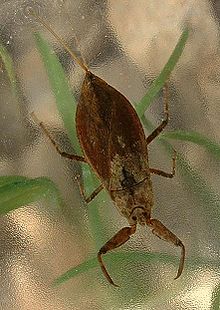
Back بقيات المياه الحقيقية Arabic بقيات المياة الحقيقيه ARZ Nepomorfs Catalan Wasserwanzen German Nepomorpha Spanish سوزنیریختان Persian Vesiluteet Finnish Punaise aquatique French Vízipoloskák Hungarian Nepomorpha Italian
| Nepomorpha Temporal range:
| |
|---|---|

| |
| Nepa cinerea, a water scorpion | |
| Scientific classification | |
| Domain: | Eukaryota |
| Kingdom: | Animalia |
| Phylum: | Arthropoda |
| Class: | Insecta |
| Order: | Hemiptera |
| Suborder: | Heteroptera |
| Infraorder: | Nepomorpha Popov (1968) |
| Superfamilies | |
|
Aphelocheiroidea | |
| Synonyms | |
|
Cryptocerata | |
Nepomorpha is an infraorder of insects in the "true bug" order (Hemiptera). They belong to the "typical" bugs of the suborder Heteroptera. Due to their aquatic habits, these animals are known as true water bugs. They occur all over the world outside the polar regions, with about 2,000 species altogether. The Nepomorpha can be distinguished from related Heteroptera by their missing or vestigial ocelli. Also, as referred to by the obsolete name Cryptocerata ("the hidden-horned ones"), their antennae are reduced, with weak muscles, and usually carried tucked against the head.[1]
Most of the species within this infraorder live in freshwater habitats. The exceptions are members of the superfamily Ochteroidea, which are found along the water's edge. Many of these insects are predators of invertebrates and in some cases – like the large water scorpions (Nepidae) and giant water bugs (Belostomatidae) – even small fish and amphibians. Others are omnivores or feed on plants. Their mouthparts form a rostrum as in all Heteroptera and most Hemiptera. With this, they pierce their food source to suck out fluids; some, like the Corixidae, are also able to chew their food to some extent, sucking up the resulting pulp. The rostrum can also be used to sting in defence; some, like the common backswimmer (Notonecta glauca) of the Notonectidae can easily pierce the skin of humans and deliver a wound often more painful than a bee's sting.
- ^ Martin B. Hebsgaard, Nils M. Andersen & Jakob Damgaard (2004). "Phylogeny of the true water bugs (Nepomorpha: Hemiptera–Heteroptera) based on 16S and 28S rDNA and morphology" (PDF). Systematic Entomology. 29 (4): 488–508. doi:10.1111/j.0307-6970.2004.00254.x. S2CID 83571115. Archived from the original (PDF) on 2007-06-11. Retrieved 2008-07-09.